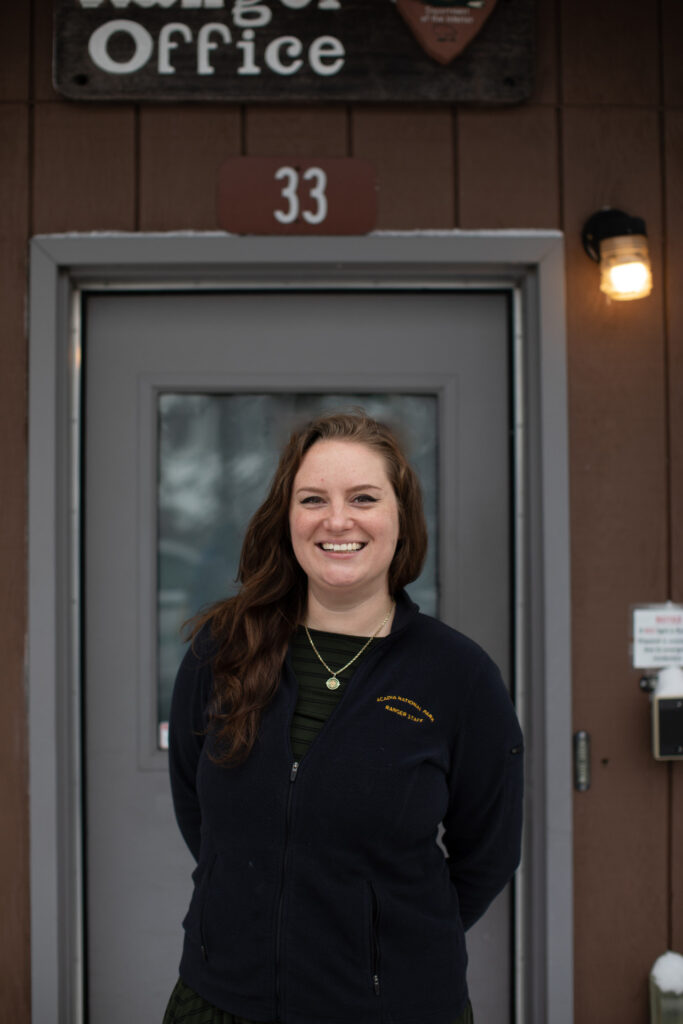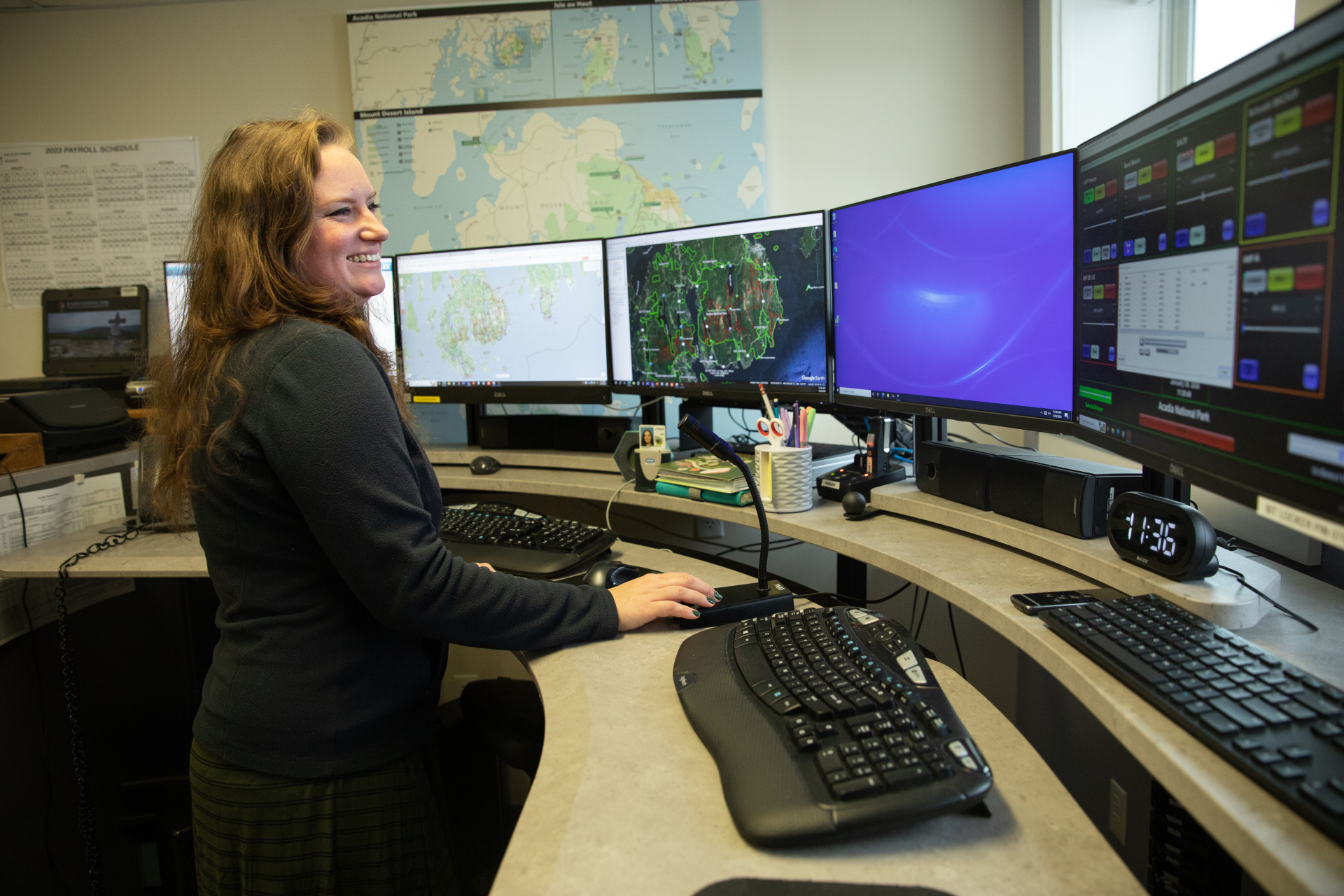Meet Brittany Ashcraft
Acadia National Park Public Safety Dispatcher
March 7th, 2024
Acadia National Park Public Safety Dispatcher
March 7th, 2024
In this series, we’re spotlighting the talented and dedicated staff of Acadia National Park who deliver an incredible visitor experience day after day. Whether working directly with park visitors or behind the scenes, seasonally or year-round, these are the people who make the park hum. They work hard and wear many hats, keeping the park in incredible shape, keeping park visitors safe, and rising to the occasion as visitation has reached peak levels in recent years. We at Friends of Acadia appreciate the work they do. Thank you!
Read all of the Front & Center stories
BY SHANNON BRYAN
Every time she answers the phone, Acadia National Park public safety dispatcher Brittany Ashcraft is ready to help whoever might be on the other end.
It could be a park visitor who’s absent-mindedly locked themselves out of their car. Or it could be a hiker whose partner has just suffered a serious injury on a trail.
With every call, Brittany becomes a critical connection between a caller who needs help and the park resources that can provide it.
“I receive calls for service,” she said. “Somebody calls me and says, ‘Hey, I’ve got this going on,’ and I work through the specifics of that call. What is it they need? What is the nature of the call? And then I dispatch the responders.”

Public Safety Dispatcher Brittany Ashcraft. (Photo by Julia Walker Thomas/Friends of Acadia)
Most calls are low level – a park visitor who misplaced their cell phone while enjoying the views from Dorr Mountain or a person who got separated from the rest of their family while exploring around Jordan Pond and needs help reuniting with them.
But sometimes the calls are high intensity. Those calls include fatalities, traumatic injuries, motor vehicle accidents, and callers who might be suicidal. The callers may be highly stressed, and the situation is urgent.
Dispatchers like Brittany need to quickly ascertain crucial information and dispatch the appropriate help.
“You never know what the next call is going to be,” Brittany said. “As a dispatcher, maintaining a readiness to respond is key because you never know if that next call is going to be a lockout or a traumatic injury.”
Dispatchers also need to be able to multitask efficiently, she said. “We use various computer programs and mapping systems to work through calls,” she said. “We have an interagency communications channel that we’re talking on, and we work very collaboratively and closely with other outside responders.”
“At any given point, we’ve got all these various computer systems open, and we’re working through all these different programs to manage whatever that specific call is.”
It’s a lot to navigate all at once, but it’s a role Brittany’s proud to be in.
“As a first responder, my whole modus operandi is just trying to do good and to help,” she said. And working for the National Park Service had been a lifelong goal.
Brittany grew up just outside Indiana Dunes National Park in Northwest Indiana, where she made memories in the woods behind her parents’ house and learned about dune ecology from an NPS ranger. But life first led her into hospitality, where she worked for nearly a decade before deciding to pursue a path toward the National Park Service.
She first worked for the Cincinnati Park Board, then in 2021 was hired as a seasonal dispatcher at Grand Teton National Park in Wyoming. “I instantly fell in love with that job and with everybody there,” she said. “And the culture of the National Park Service—I was just absolutely blown away.”
Brittany landed in Acadia in the fall of 2021 in a permanent position. Since then, she’s helped people in ways that reach well beyond her role as dispatcher.

Public Safety Dispatcher Brittany Ashcraft in the dispatch office at Acadia
National Park headquarters. (Photo by Julia Walker Thomas/Friends of Acadia)
She’s one of Acadia’s wellness coordinators, helping connect park employees to wellness resources, as well as a peer-support specialist, part of an NPS-wide team whose purpose is to provide support to NPS peers experiencing a personal emergency.
For her, there’s a key skill necessary to assisting those who need help.
“This job is all about compassion,” she said. “Understanding that we are in the business of interacting with other humans who are potentially going through one of their worst and darkest moments.”
If a caller is panicking or in a lot of pain, Brittany’s aim is to calm them. “Whether they’re lost or injured, I try to create that sense of confidence. I’m on this phone with them right now and we are here together, and we are going to work through this.”
In several cases, Brittany’s been able to walk out a lost hiker over the phone (editor’s note: many areas of Acadia do not have cell coverage, so visitors shouldn’t rely on their phones).
That’s a testament to Brittany’s dedication to her role. When she first came to Acadia, she made a point of learning the park’s layout and trail system by studying maps and getting out into the park and experiencing it herself.
“That’s one thing that I say when I’m training new dispatchers: You’ve got to know your park, you’ve got to get out, see it, and know what its challenges are,” she said.
Sometimes, she’s able to provide more critical assistance. “I am a certified emergency medical dispatcher, which means I can provide life-saving instructions over the phone to callers, such as CPR. I will be teaching CPR to park staff this spring,” she said.
Emergency medical dispatchers also provide instructions on how to recognize signs of a stroke, deploy aspirin for suspected heart attacks, epinephrine for severe allergic reactions, and naloxone in the event on a suspected overdose. In rare cases, they can instruct the caller on how to deliver a baby.
Whatever the need, Acadia’s dispatchers will answer the call.
“We’re the calm voice on the other end of the line to get you through arguably what might be the hardest day in your life,” Brittany said. “So that’s what we’re here to do.”
SHANNON BRYAN is Friends of Acadia’s Content and Website Manager.
If there are trails you want to explore, research their ruggedness and elevation gain before you go (apps like AllTrails are helpful for this). Many trails in Acadia feature boulders and terrain that requires specific footwear or traction and are more hazardous in certain conditions.
Have a paper map on hand to help you navigate the trails or figure out where you are should you discover you’re lost. Many areas of Acadia don’t have cell service, so a paper map will help you find your way.
Communicate with a friend or family member where you’re going and when you plan to be
back. If you don’t turn up, they’ll be able to reach out to responders for help and the responders will know where to look for you. Have a plan for your hiking group, too. If someone gets separated, have a plan on where to meet up.